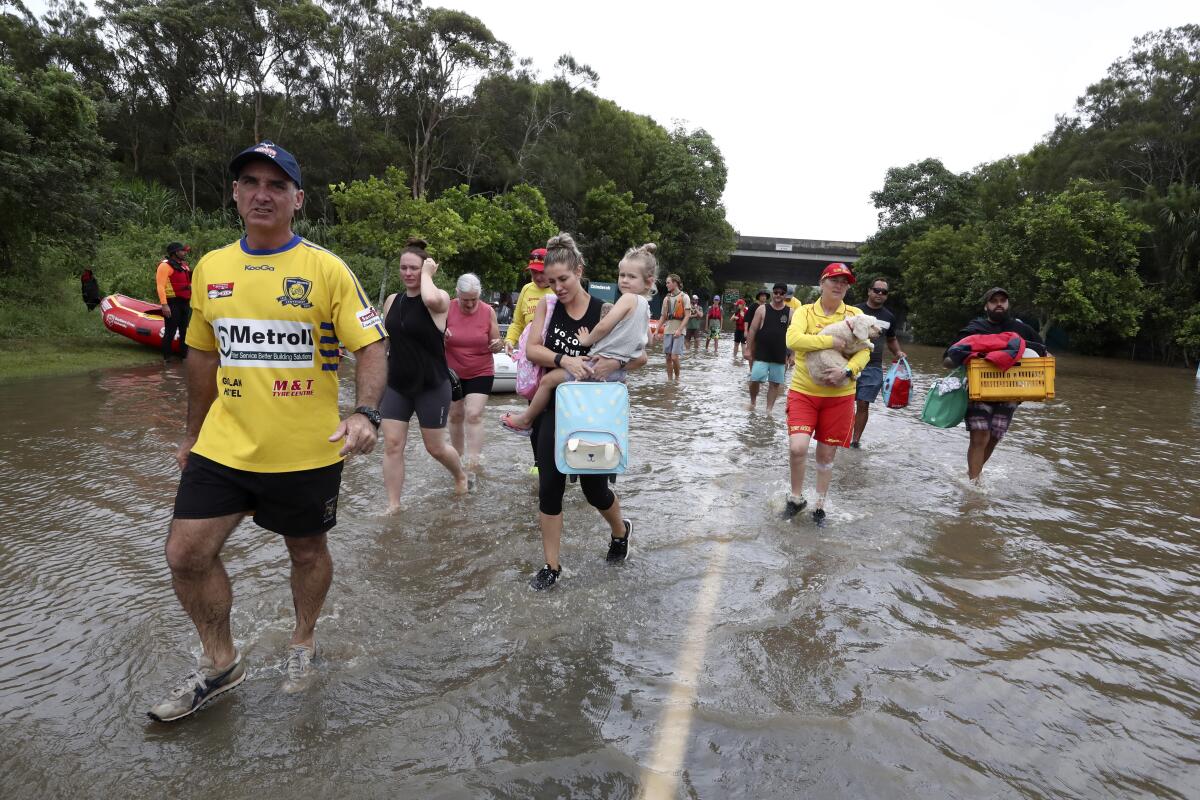Thousands evacuated, at least 10 dead in Australia’s worst floods in decades

- Share via
BRISBANE, Australia — Tens of thousands of people were ordered to evacuate their homes by Tuesday and hundreds of thousands more were told to prepare to flee as parts of Australia’s southeast coast were inundated by the worst flooding in more than a decade. At least 10 people have died.
New South Wales Premier Dominic Perrottet said there had been 1,000 rescues in the state by Tuesday and more than 6,000 calls for authorities to help.
Scores of residents, some with pets, spent hours trapped on their roofs by a fast-rising river in the town of Lismore in northern New South Wales.
The body of a woman in her 80s was found by a neighbor in her Lismore home Tuesday, a police statement said. There were no details of how she died.
Dozens of cars were trapped on a bridge in the nearby town of Woodburn through Monday night, with both the bridge’s approaches submerged. Up to 50 people were rescued from the bridge early Tuesday, officials said.
“We had no capabilities to get them off in the dark so we just had to make sure that they bunkered down, and we went in this morning and got them all out,” Woodburn State Emergency Services Commander Ashley Slapp said.
Koalas have been declared officially endangered in eastern Australia as they succumb to disease, lost habitat and other threats.
The floodwaters are moving south into New South Wales from Queensland state in the worst such disaster in the region since what was described as a once-in-a-century event in 2011.
Perrottet said 40,000 people had been ordered to evacuate and 300,000 others had been placed under evacuation warnings.
Government meteorologist Jonathan Howe described the amount of recent rainfall in northern New South Wales and southern Queensland as “astronomical.”
Nine of the 10 deaths reported so far were in Queensland. A 76-year-old man who disappeared with his vehicle in floodwater northwest of the capital, Brisbane, on Sunday has since been confirmed dead.
Queensland Police Commissioner Katarina Carroll said another man in his 70s remained missing after falling from his moored yacht in the state capital, Brisbane, into a swollen river on Saturday.
The cleanup was underway in Brisbane, Australia’s third-most populous city, despite more storms forecast for later in the week. Brisbane Lord Mayor Adrian Schrinner urged people to sign up for the “Mud Army,” as the thousands of volunteers who mobilized to help out after the 2011 floods were dubbed.
A United Nations report is painting a dire picture of the Great Barrier Reef’s future.
Thousands of homes in Brisbane were inundated Sunday, many by destructive surges in swollen creeks in suburbs such as Ashgrove, where Kelvin Barfoot had to evacuate with members of his family, including his 99-year-old mother-in-law, Mina Baker, in a State Emergency Service rescue boat.
The family moved back into the top floor of their two-story home and started removing damaged furniture and electrical appliances that had been covered by almost five feet of floodwater.

“We thought we were pretty well-prepared for it,” said Barfoot, who leads a volunteer bush care group which has tallied more than 4,000 hours of planting and weeding along Enoggera Creek over the past six years. “Just unbelievable. When it did start coming in, it went up very quick.”
Barfoot said his daughter and her husband swam to the house to help with the rescue after notifying emergency services that her grandmother — who moved to Australia from Christchurch, New Zealand, after earthquakes there in 2011 killed 185 people — needed to get out.
“We were pretty much stuck upstairs at that point,” Barfoot said. “That was quite traumatic for my mother-in-law — we got her out [of New Zealand] after the earthquakes, so it was all a bit reminiscent of that for her.”
Schrinner said the six-day total rainfall for downtown Brisbane — 31.2 inches as of Monday morning — was significantly higher than the previous record of 25.8 inches, which was set when flooding devastated the city in 1974.
The Inyo rock daisy only grows in the crevices of cliff walls in the southern Inyo Mountains near Death Valley National Park.
Rick Threlfall and Steve Hadley, meteorologists who moved from England to Australia and have been living in Newmarket, Brisbane, for almost a decade, were in the process of sandbagging the ground floor of their home but couldn’t finish in time to beat the rapidly rising flood.
“Back in the U.K., we do weather warnings for 20 millimeters [1 inch] of rain,” Threlfall said. “My weather gauge here has recorded 950 millimeters [37 inches] in three days. Brisbane’s average is about 1,200 millimeters [47 inches] for the year, so we’ve pretty much had 80% of annual rainfall in three days.”
The extraordinary rainfall comes as the United Nations’ Intergovernmental Panel on Climate Change reported this week that vast swaths of Australia have already lost 20% of its rainfall and the country’s fire risk has gone beyond worst-case scenarios developed just a few years ago.
Australia’s hottest and driest year on record was 2019, which ended with devastating wildfires across southeast Australia. The fires directly killed 33 people, and another 400 people were killed by the smoke.
Record heat. Raging fires. What are the solutions?
Get Boiling Point, our newsletter about climate change, the environment and building a more sustainable California.
You may occasionally receive promotional content from the Los Angeles Times.
The fires also destroyed more than 3,000 homes and razed 47 million acres of farmland and forests.
But two La Niña weather patterns have since brought above-average rainfall to the same regions.
Lesley Hughes, an Australian academic and former lead author of the U.N. panel’s assessment reports in 2007 and 2015, said climate change was expected to overwhelm government systems such as flood responses.
“We can see that our emergency services are struggling already to cope with the floods in northern New South Wales, with people stranded on roofs without food for more than 24 hours,” Hughes said.
More to Read
Sign up for Essential California
The most important California stories and recommendations in your inbox every morning.
You may occasionally receive promotional content from the Los Angeles Times.














